
Let's look at four very different spaces or habitats in which alternative publics may be constructed: a homeless shelter in Atlanta, a community garden in New York, the GroWorld hybrid media / physical garden project, and the Hubbub speech-painting public space project.
Peachtree Pine: Cooking with Matter, Cooking with Media
The Peachtree Pine Center for the Homeless, which occupies a whole city block in the heart of in downtown Atlanta, Georgia, is the only place in the city which places no thick filter of conditions which must be satisfied by a person in order to be admitted to shelter. Though dedicated as a place of last resort for the indigent, it is being built as a porous space, a place in which certain social boundaries are meant to leak. For example, one large ground floor area will be a dining hall where people can cook or eat in a common area. It also will serve as a place for people to come and buy a meal as at any midtown restaurant, paying if they have the means.
The rooftop of the Peachtree Pine Center will be have space reserved for a community garden, but for several other activities, too, including public projection art and performance.
The ground floor has a T1 line that lays the foundation for residents to emit and receive media using public webcast technologies. People can come to together to prepare and share media as they cook and share food. By design this may become a site where people come to learn how to articulate themselves in other media as well: they will have a chance to learn how to make their own media and their own material artifacts. Residents who gained technical experience in the failed computer businesses have begun to assemble equipment for the computer access labs.
Radical Ecology, Urban Living
The Turtle Squat and Green Dome Garden are but two of several dozen community gardens grown in the interstices between urban developments in New York City. These gardens became sites for gatherings, alternative tours through the unknown greens of the city, informally coordinated puppetry performances, ecological demonstrations and activist workshops. The gardens serve not only as detoxifying elements in an otherwise extremely polluted urban environment, but also as alternative public spaces -- havens for imagination and drifting unfettered by economic or racial discrimination.
These rich socialities hover on the edge of existence in the interstitial spaces of their urban environment and economy. They've grown organically from the needs of their constituent communities. Let's look at two examples of experimental media-augmented public spaces that may open up yet other modes of alternative sociality. Then we will extract some commonalities that could be useful for the design of enlivening public spaces. We propose two projects – Hubbub and GroWorld – as case studies for a socio-cultural pattern sustaining diversity spanning across discontiguous social, organic and cultural domains.
The pattern described in this paper is based on the assumption that social interaction and exchange can take advantage of the information technologies to augment site-specific urban contexts with a layer of digital media that can be shared between several localities and communities. By developing (elements of) spaces that can be seen as autonomous 'live' entities, the public arenas acquire additional layers of interaction (human-human, human-built space, human-media space...), that potentially can generate fresh and more richly nuanced forms of social capital.
Hubbub
Hubbub, a project developed in the Topological Media Lab at Georgia Institute of Technology, is an investigation of how accidental and non-accidental conversations can by catalyzed in urban spaces by means of speech projected onto public surfaces. Hubbub installations may be built into a bench, in a bus stop, a bar, a cafe, a school courtyard, a plaza, a park. As you walk by a Hubbub installation, some of the words you speak will dance in projection across the surfaces according to the energy and prosody of your voice. We capitalize on recognition errors to give a playful character to the space. A Hubbub' installation succeeds to the degree in which strangers who revisit such an augmented space begin to interact with one another socially in ways they otherwise would not. Hubbub is a part of a larger research project which explores how cities conduct conversations via the architecture of physical and computational matter.
In the dystopic future of Luc Besson's film "The Fifth Element," police conducted raids on tenements dressed like spacesuited shock troops. Armed to the teeth, they burst into rooms and cabs, broadcasting / bull-horning as they extract citizens from their cells or vehicles the refrain: "Thank you for your cooperation." In public space, language is typically used in a lattice -- grammatical and disciplining (viz. an airport's audio instructions: "Stay on the right side of the slideway, please let others pass on your left...") In Besson's film, the police's refrain – "Thank you for your cooperation." – emblematically marks how public media have become ever more explicitly instruments of behavioral control.
We maintain that sociality is an intrinsic part of human life, of what makes urban life exceed its death, but we also maintain that it must grow from ordinary, unscripted gesture and talk. It cannot be laid down as a matrix of behavior from loudspeakers, whether delivered in the honey tones of the Charles de Gaulle Aiport's announcer or in the sum of sines of a TI voice chip. To be viable it can only spring from the detritus of everyday conversation, perhaps worked by art, but perhaps also merely as sprouts between the cracks of a language laid under the concrete matrix of slogans and jingles and macros of speech made as a sequence of forced moves, used by people when they find nothing to say to one another.
[example: Glenn Gould's radio jam session using speech sampled from a diner. CBC recording]
In Hubbub, we are studying how speech recognition technology could be used to augment a common public space, to render it more vital, to make its surfaces and volumes register speech in common so that over days, weeks and months, this detritus of speech and conversation, jive, wordplay, catcalls, epithets, songs, will layer and convect and sustain a garden of fresh common language games.
Weed talk, wilderness voices
We treat live speech not as a medium for explicit communication but as a living medium for architectural construction. By projecting some animated glyphs homologous to the spoken speech, we give speech some of the fixity of text and text some of the prosody of speech. But we do not presume to make a deterministic word game out of Hubbub, preferring instead to turn the accidents of the speech recognizer to advantage in a phonic game for the passing speakers.
In San Francisco, we have built two tests: an outdoor installation where we projected animated glyphs on steel cloth by the waterfront, and an indoor installation where we projected recognized speech as glyphs animated by the timbre, pitch, stereo-location and other features of the speaker's voice. In each case we carefully designed the sculptural installation for the physical setting, the social ambience and the potential for ludic activity.
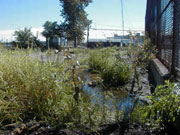
from: http://www.gaia-inst.org/
presentations/weeds.htm
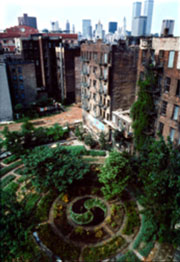 from: "Build
a garden on the site
from: "Build
a garden on the siteof the destroyed WTC"
http://www.nyc.indymedia.org/
front.php3?article_id=15735
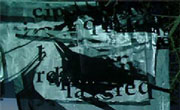
hubbub detail 01
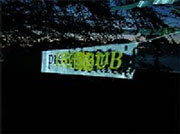
hubbub detail 02
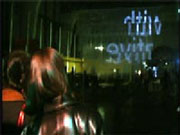 Plaza Hubbub, Teleopolis
Festival, San Francisco Exploratorium
Plaza Hubbub, Teleopolis
Festival, San Francisco Exploratorium back to sponge >